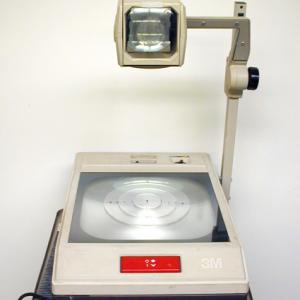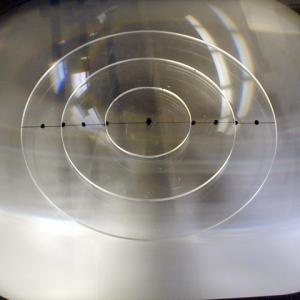College of Liberal Arts & Sciences
3B45.05 - Doppler Effect and Shock Waves - Overhead Projector Plates
Place the three Plexiglass plates on the overhead projector. Start with the center of all three plates in the same position. Re-position the plates to the doppler configuration desired.
- Figuring Physics, TPT, Vol. 58, #2, Feb. 2020, p. 135.
- Correction: Paul Gluck, "Moving Sources: Doppler Beats and Mach Cones", TPT, Vol. 43, # 9, Dec. 2005, p. 567.
- Paul Gluck, "Moving Sources: Doppler Beats and Mach Cones", TPT, Vol. 43, # 6, Sept. 2005, p. 371.
- Robert Alt and Sam Willey, "A Generalized Wave Diagram for Moving Sources", TPT, Vol. 42, # 9, Dec. 2004, p. 526.
- William P. Brown, "The Doppler Demonstration", TPT, Vol. 27, # 8, Nov, 1989, p. 635.
- W. Klein, G. Nagel, "Continuous Ripple-Tank Demonstration of Doppler Effect", AJP, Vol. 48, # 6, June 1980, p. 498.
- P. C. B. Fernando, "A Simple Ripple Tank Demonstration of the Doppler Effect and the Bow Shock", AJP, Vol. 43, #1, Jan. 1975, p. 101.
- Robert Ehrlich, "8.15, Doppler Effect and Shock Waves", Why Toast Lands Jelly-Side Down, p. 139.
- David Kutliroff, "20, A Doppler Effect Demonstration with Water Waves", 101 Classroom Demonstrations and Experiments For Physics Teachers, p. 49.
- Jearl Walker, "2.68, Wakes of Ducks and Aircraft Carriers", The Flying Circus of Physics Ed. 2, p. 109.
- Curt Suplee, "Resonance and interference", Everyday Science Explained, National Geographic, p. 62.
Disclaimer: These demonstrations are provided only for illustrative use by persons affiliated with The University of Iowa and only under the direction of a trained instructor or physicist. The University of Iowa is not responsible for demonstrations performed by those using their own equipment or who choose to use this reference material for their own purpose. The demonstrations included here are within the public domain and can be found in materials contained in libraries, bookstores, and through electronic sources. Performing all or any portion of any of these demonstrations, with or without revisions not depicted here entails inherent risks. These risks include, without limitation, bodily injury (and possibly death), including risks to health that may be temporary or permanent and that may exacerbate a pre-existing medical condition; and property loss or damage. Anyone performing any part of these demonstrations, even with revisions, knowingly and voluntarily assumes all risks associated with them.



